Saltwater Crocodile (Crocodylus porosus)
Welcome to the world of the Saltwater Crocodile, scientifically known as Crocodylus porosus. These magnificent creatures are the largest living reptiles on the planet and have roamed the Earth for millions of years.
Found in the brackish and freshwater regions of Southeast Asia and Australia, Saltwater Crocodiles are apex predators with a diet that ranges from fish and crabs to buffalo and even humans.
Join us as we dive into the fascinating world of these prehistoric creatures, exploring their habitat, diet, behavior, and much more.
Update: This article was recently updated, We hope you like the new content! 😉
Overview
| Category | Information |
|---|---|
| Kingdom | Animalia |
| Phylum | Chordata |
| Class | Reptilia |
| Order | Crocodilia |
| Family | Crocodylidae |
| Genus | Crocodylus |
| Species | Crocodylus porosus |
| Common | Saltwater crocodile, estuarine crocodile |
| Habitat | Coastal and brackish waters, mangrove swamps |
| Diet | Opportunistic predator, eats a variety of species including fish, crabs, birds, turtles, etc. |
| Size | Males up to 4-6 m (13-20 ft), females up to 2-3 m (6.6-9.8 ft) |
| Weight | Males up to 1,000-1,200 kg (2,200-2,600 lbs), females up to 400 kg (880 lbs) |
| Lifespan | Up to 70 years in the wild |
| Behavior | Solitary and territorial, vocal communication |
| Threats | Habitat loss, poaching, conflict with humans |
| Status | Least Concern (IUCN Red List of Threatened Species) |
The Largest Reptile in the World: Australian Saltwater Crocodile
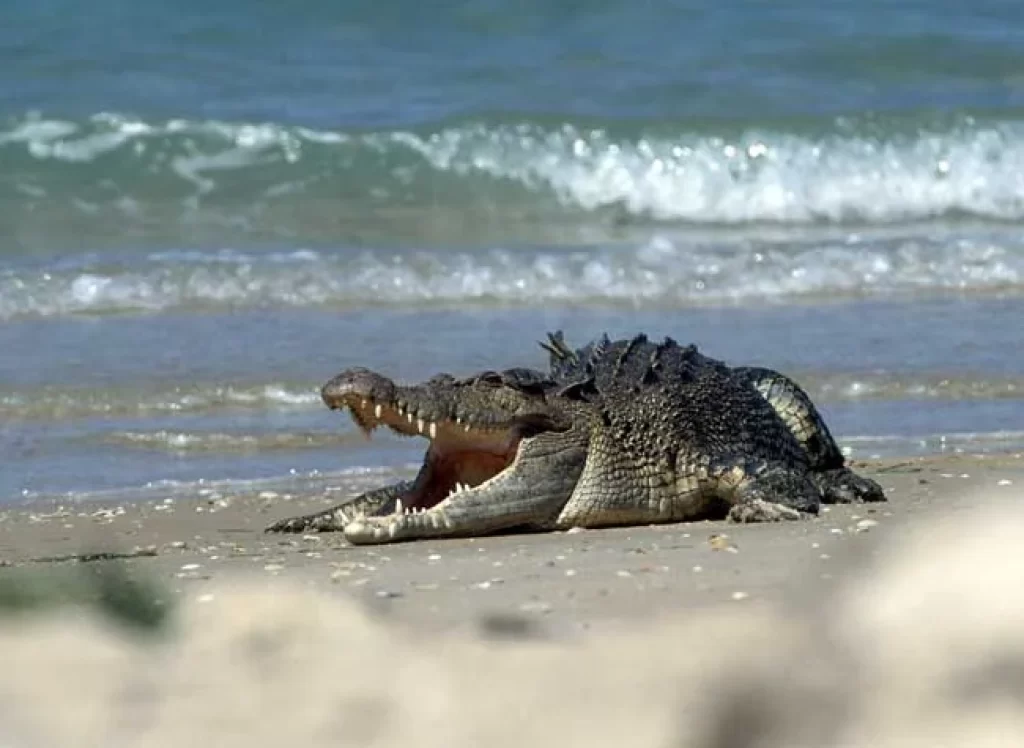
Description of Saltwater Crocodiles
Saltwater crocodiles, scientifically known as Crocodylus porosus, are the largest living reptiles on Earth. Adult males can reach impressive lengths of 6 to 7 meters (20 to 23 feet) and weigh between 1,000 to 1,200 kilograms (2,200 to 2,600 pounds). In contrast, females are considerably smaller and typically do not exceed 3 meters (10 feet) in length.
These crocodiles possess a robust and muscular body, which sets them apart from other crocodile species. Their massive heads feature a pair of prominent ridges that run from the eyes along the center of the snout. With a formidable jaw equipped with 64 to 68 teeth, saltwater crocodiles have a fearsome appearance.
Compared to most crocodiles, saltwater crocodiles have a wider snout, giving them a distinctive look. However, their snouts are longer than those of mugger crocodiles, with a length that is twice their width at the base.
The scales of saltwater crocodiles are oval-shaped, and their scutes, or bony plates, are relatively small compared to other crocodile species. In some cases, these scutes may be entirely absent. This unique characteristic is beneficial in distinguishing saltwater crocodiles in captivity or in the illegal trade of their valuable skin. It is also helpful for identifying sub-adult or younger saltwater crocodiles in the field.
Coloration and Appearance
The coloration of saltwater crocodiles varies depending on their age. Young saltwater crocodiles display a striking pattern with pale yellow bodies adorned with black stripes and spots. This vibrant coloration lasts for several years until they reach adulthood.
As adults, their coloration changes to a darker greenish-drab, with a few lighter tan or gray areas sometimes visible. Some individuals may retain fairly pale skin, while others appear almost blackish. The ventral surface, or belly, of saltwater crocodiles is typically white or yellow in color at all ages. Stripes can be observed on the lower sides of their bodies, but these markings do not extend onto their bellies. Their tails are characterized by gray coloration with dark bands.
Communication and Behavior
Saltwater crocodiles are regarded as highly intelligent and sophisticated animals. They communicate with each other using a range of vocalizations. They are known to emit barks, hissing sounds, and distinct calls depending on the situation.
Juvenile saltwater crocodiles produce a high-pitched distress call consisting of a series of short barks, indicating their vulnerability or need for assistance. When faced with intruders or threats, saltwater crocodiles emit threatening hisses as a form of defense. Newborn saltwater crocodiles perform a hatching call, a high-pitched short bark that likely serves to communicate their presence to their mother. Finally, during courtship and mating, adult saltwater crocodiles emit a long, low growl known as the courtship bellow.
Thermoregulation
Saltwater crocodiles are ectothermic creatures, meaning they rely on external sources of heat to regulate their body temperature. To maintain their preferred body temperature, they use a combination of behaviors. They bask in the sun to absorb warmth and then cool themselves by submerging in water. This thermoregulation allows them to adapt to a range of environmental conditions.
Aggression and Danger
Saltwater crocodiles are renowned for their aggressiveness and are considered one of the most dangerous reptiles in the world. They are apex predators and have been known to attack and prey upon a wide range of animals, including other crocodiles, mammals, birds, and even sharks. Tragically, there have been cases of saltwater crocodile attacks on humans, some of which have resulted in fatalities.

Saltwater crocodiles are easily identifiable by their large head and broad snout, which distinguishes them from other species of crocodiles.
Their snouts also feature a pair of ridges that run from the eyes along the center. In addition, they have oval scales and smaller scutes compared to other crocodile species.
As juveniles, they have a pale yellow coloration with black stripes and spots on their body and tail.
Habitat of Saltwater Crocodiles

Saltwater crocodiles, also known as salties or saltwater crocs, are incredibly adaptable reptiles that can thrive in both freshwater and saltwater habitats. Let’s explore their habitat in more detail.
Freshwater Habitats
Saltwater crocodiles are found in a variety of freshwater environments, including rivers, lakes, and inland swamps and marshes.
These habitats provide the crocodiles with ample opportunities for hunting, breeding, and finding shelter. In Australia, saltwater crocodiles can be observed in numerous rivers, such as the Mary, Adelaide, Daly, Moyle, Victoria/Baines, Finniss, Wildman, West Alligator, East Alligator, South Alligator, Liverpool, Blyth, Glyde, Habgood, Baralminar/Gobalpa, Goromuru, Cato, and Peter John Rivers.
They have adapted to the diverse conditions and ecosystems of these river systems. In Western Australia, saltwater crocodile populations thrive in major river systems of the Kimberley region, including the Ord, Patrick, Forrest, Durack, King, Pentecost, Prince Regent, Lawley, Mitchell, Hunter, Roe, and Glenelg Rivers. Parrys Creek is another notable location where they can be found.
Saltwater and Coastal Habitats
Saltwater crocodiles are well adapted to brackish and saltwater environments, making them highly successful in coastal areas and estuaries.
Along the Australian coastline, saltwater crocodiles inhabit regions ranging from Rockhampton in Queensland to King Sound in Western Australia. This includes the coastal areas of the Northern Territory.
Queensland hosts saltwater crocodile populations in reef, coastal, and inland waterways, stretching from Gladstone on the east coast to the Queensland-Northern Territory border. Sightings of saltwater crocodiles have been recorded in various locations in Australia, such as the Southern Gulf Plains, Northern Gulf Plains, northwest and northeast Cape York Peninsula, Lakefield National Park, East Coast Plains, the Burdekin River catchment, and the Fitzroy River catchment.
Other Regions
Saltwater crocodile populations can also be found beyond Australia, with sightings reported in different parts of the world. In India, Southeast Asia, the Philippines, Papua New Guinea, Palau, the Solomon Islands, and Vanuatu, saltwater crocodiles occupy suitable habitats within these regions.
There have been isolated sightings of saltwater crocodiles in the Pilbara region of Western Australia, near Derby and Broome. Some have even been observed as far south as Carnarvon on the mid-west coast.
Saltwater crocodiles showcase their remarkable adaptability by occupying diverse habitats, including both freshwater and saltwater environments.
This adaptability, along with their ability to regulate body temperature, secure food sources, and find suitable nesting areas, has contributed to their wide distribution and ability to thrive in various regions across the globe.
Diet of Saltwater Crocodiles
Saltwater crocodiles, also known as “salties” in Australia, are apex predators with a diverse diet. They feed on a wide range of prey, including small reptiles, turtles, fish, and wading birds.
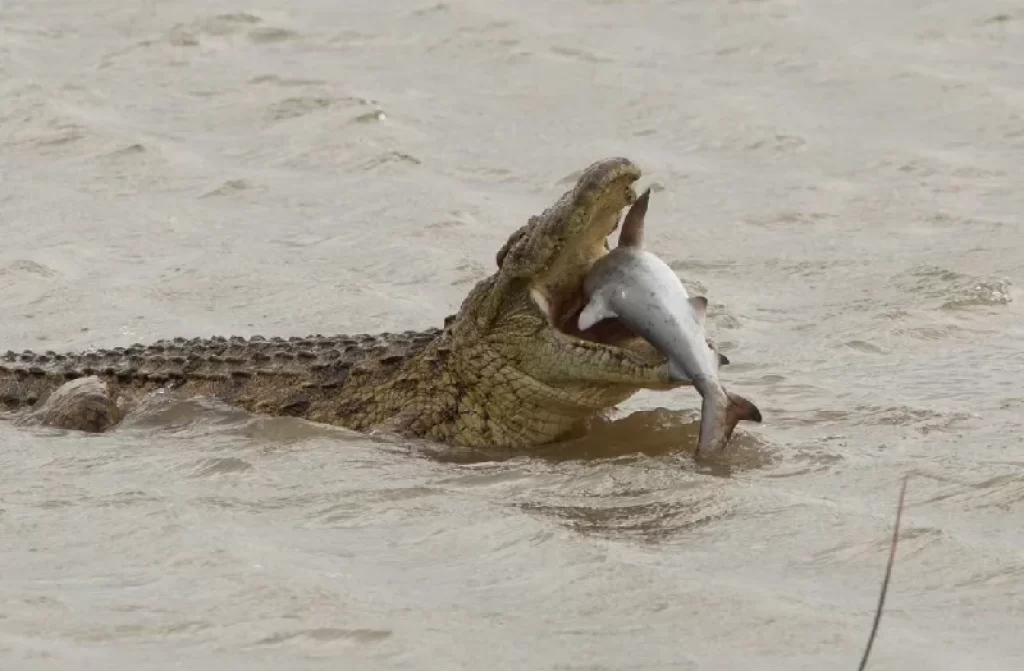
They are also known to target larger prey such as wild boars that come to drink at waterholes or riverbanks near their habitat. Additionally, saltwater crocodiles have been observed preying on sea turtles, other crocodiles, and unfortunately, even humans who venture too close to their territory.
Diet of Hatchlings and Juveniles
The diet of hatchlings, juveniles, and subadult saltwater crocodiles has been extensively studied compared to fully-grown crocodiles. Hatchlings primarily feed on smaller animals such as small fish, frogs, insects, and small aquatic invertebrates.
As they grow into juveniles, their diet expands to include a variety of freshwater and saltwater fish, amphibians, crustaceans, molluscs, birds, and small to medium-sized mammals. They also prey on other reptiles like snakes and lizards, taking advantage of the available food sources in their environment.
Variety in Diet as They Grow
As saltwater crocodiles grow, their diet continues to increase in variety. While they still consume relatively small prey throughout their lifetime, they exhibit preferences based on their size and habitat. For example, in mangrove habitats, large mud crabs of the genus Scylla are frequently consumed as part of their diet.
Ground-living birds, such as emus and various water birds like the magpie goose, are commonly preyed upon due to their increased chance of encounter. Saltwater crocodiles are opportunistic feeders, targeting swift-flying birds, bats, and a range of mammals, including wallabies, jackals, viverrids, turtles, flying foxes, hares, rodents, badgers, otters, chevrotains, and pangolins.
Interaction with Cane Toads
Studies have shown that saltwater crocodiles have developed partial resistance to cane toad toxins, allowing them to consume these invasive pests. However, they can only tolerate small quantities of the toxins and do not provide effective natural control for the cane toad population. While they may prey on cane toads, it is not a primary food source for saltwater crocodiles.
Hunting Techniques and Prey Selection
Saltwater crocodiles are skilled hunters that predominantly hunt in water, but they can also ambush and attack larger prey on land. Their powerful jaws allow them to crush prey that weighs several tons. They employ various hunting techniques and adapt their prey selection according to availability.
While they are capable of capturing a wide range of prey species, saltwater crocodiles are not voracious eaters and can survive on relatively little food for extended periods of time.
Capturing Adult Saltwater Crocodiles
Capturing adult saltwater crocodiles for research or management purposes is a challenging task due to their size, aggression, and territoriality. One method used is a large pole with hooks designed for shark capture, which restrains the crocodile’s jaws. However, this method can cause damage to the crocodile’s snout. Capturing crocodiles exceeding 4 meters in length using this method has not been proven.
Hunting Techniques of Saltwater Crocodiles
Crocodilians, including saltwater crocodiles, are renowned for their stealthy and effective hunting methods. They employ a combination of speed, strength, and strategy to capture their prey. Similar to other crocodilians, saltwater crocodiles will submerge themselves and silently swim towards their prey before suddenly pouncing upwards to strike. Young saltwater crocodiles have also been observed breaching their entire bodies into the air in a single upward motion to catch prey perched on low hanging branches.
Highly Organized Game Drives
One fascinating hunting behavior observed in crocodilians is the use of highly organized game drives. For instance, crocodiles have been seen swimming in a circle around a shoal of fish, gradually tightening the circle until the fish are forced into a tight “bait ball.” The crocodiles then take turns cutting across the center of the circle to snatch the fish. Alligators exhibit a similar tactic, driving fish from deeper parts of a lake into shallower areas where smaller, more agile alligators block their escape.
Tail Use in Hunting
Crocodiles have also been observed using their tails to knock prey into the water. For example, when hunting rhesus macaques, crocodiles have been seen knocking the monkeys off a bank with their tail, forcing them into the water for easy consumption. While it is unclear whether tail use in hunting is intentional or accidental, it is evident that crocodilians have developed various hunting techniques to suit their needs.
Capture and Consumption of Prey
Once prey is captured, crocodiles employ their sharp, peg-like teeth to grip and hold the prey, rather than shear flesh. Small prey is typically swallowed whole, while larger animals are dragged into deep water and drowned or crushed. To manage larger prey, crocodiles employ techniques like “death rolling,” where they twist their bodies to tear the prey into manageable pieces. Occasionally, crocodiles may store food items for later consumption, although this can attract scavengers.
Intelligence and Adaptability
Crocodilians, including saltwater crocodiles, display remarkable intelligence and adaptability in their hunting behaviors. They exhibit the ability to anticipate each other’s positions and actions without direct visual contact, as seen in the circumstances surrounding the pig’s demise. This indicates their capacity for coordination and communication.
The reproductive behavior and maternal care of saltwater crocodiles
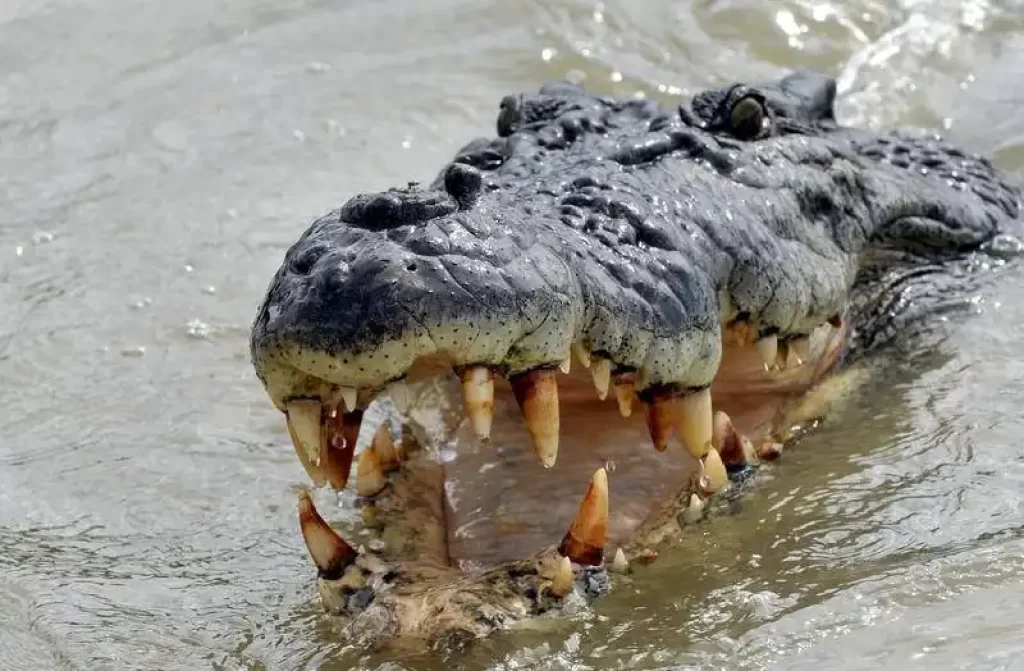
Nesting Behavior
The nesting behavior of female saltwater crocodiles is an essential aspect of their reproductive cycle. They construct nests made of mud and vegetation, carefully selecting the location along tidal rivers or freshwater areas, particularly in swamps.
The nests are typically about 175cm long and 53cm high, providing ample space for the eggs. To protect the nest and conceal it from potential predators, the female crocodile often covers the entrance, which averages 160cm in diameter, with a layer of leaves and debris. This camouflage helps to ensure the safety of the developing eggs.
Parental Care
Both male and female saltwater crocodiles are involved in defending the nesting territory. However, it is primarily the female who takes on the responsibility of guarding the nest until the eggs hatch. This period of vigilance lasts for an impressive 80-98 days, during which the female exhibits a remarkable level of dedication and attentiveness.
She remains close to the nest, protecting it from potential threats and regulating the temperature by adjusting her body position and the covering material. The female’s commitment to safeguarding the nest contributes significantly to the survival of the developing embryos.
Sex Determination and Hatchlings
One intriguing aspect of saltwater crocodile reproduction is the temperature-dependent sex determination of the hatchlings. The sex of the offspring is determined by the incubation temperature experienced during a critical period of embryonic development. Temperature ranges between 28-30 degrees Celsius result in the production of exclusively female hatchlings.
In contrast, temperatures between 30-32 degrees Celsius lead to the emergence of predominantly male hatchlings, accounting for approximately 86% of the offspring. When the temperature rises to 33 degrees Celsius or higher, female hatchlings once again become the majority. This unique mechanism adds an interesting dimension to the crocodile’s reproductive strategy.
Maternal Care
Female saltwater crocodiles display an exceptional level of maternal care towards their hatchlings. After the eggs hatch, the female responds to the “yelping” calls of the young ones by excavating the nest and assisting the hatchlings in emerging. She carefully carries them to the water, gently holding them in her powerful jaws, and remains with them for several months. During this period, the female provides protection, guidance, and even some nourishment for her offspring. She exhibits a keen sense of awareness and actively defends her young from potential threats, ensuring their survival during the vulnerable early stages of their lives.
Reproductive Physiology
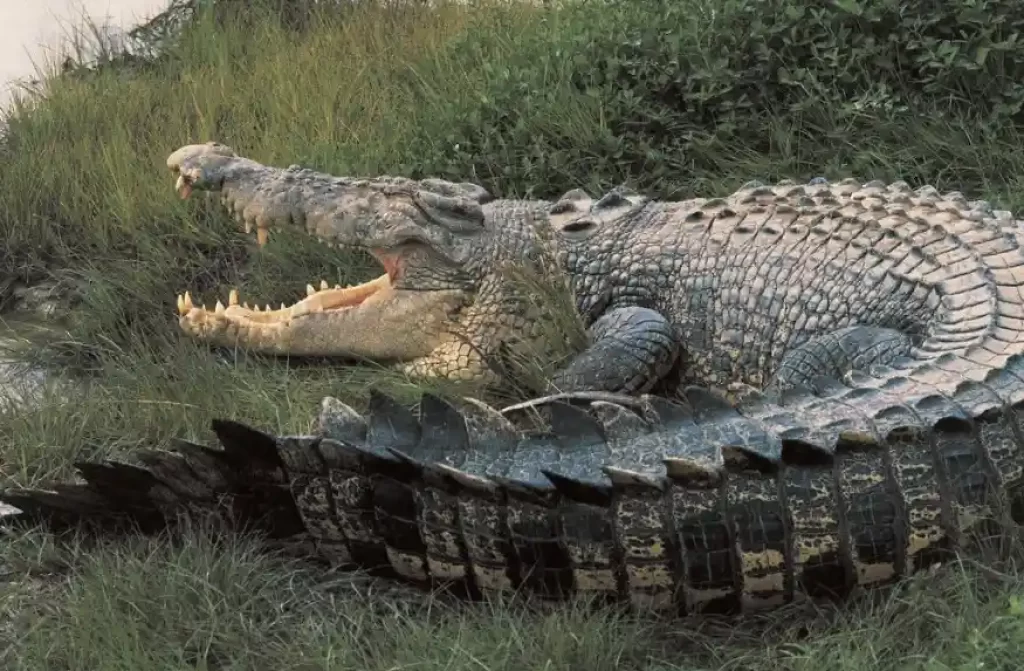
Before the female saltwater crocodile reaches the stage of laying eggs, she undergoes significant physiological changes as she matures. Male saltwater crocodiles typically reach sexual maturity at around 3.3 meters in length and approximately 16 years of age. In contrast, females attain sexual maturity at a smaller size of about 2.1 meters and between 12-14 years of age. These developmental milestones mark the readiness for reproductive activities, including courtship and mating.
Nesting Sites and Eggs
The selection of appropriate nesting sites by female saltwater crocodiles is crucial for the survival of their offspring. They prefer locations near the water’s edge, ensuring easy access to water for both the female and the hatchlings. By choosing such sites, they can protect the nests from potential predators, such as monitor lizards or snakes, which may attempt to raid the eggs for food.
The eggs themselves are approximately 8 by 5cm in size and weigh around 113g in Australia and 121g in India. Although the female crocodile invests considerable effort in creating a secure nest, the success of nesting can be influenced by various factors, including flooding and predation.
Remarkably, nests have been observed in unexpected habitats, such as rocky rubble or damp low-grass fields, highlighting the adaptability of these reptiles.
Threats
Despite their size and strength, saltwater crocodiles face many threats. Habitat loss is a significant problem as humans continue to encroach on their territory for development purposes. Hunting for their skin and meat has also been a major factor in the decline of their population.
Conservation Efforts
To protect these magnificent creatures, conservation efforts have been put in place. In Australia, saltwater crocodiles are protected under national law, and it is illegal to hunt or kill them without a permit. Additionally, many wildlife organizations work tirelessly to educate the public about the importance of preserving these animals and their habitats.
Lifespan of Australian Saltwater Crocodiles
Australian saltwater crocodiles have a lifespan of up to 70 years in the wild. However, their longevity depends on various factors such as habitat quality and availability of food sources. In captivity or protected environments such as national parks or zoos where they receive proper care and nutrition, they can live even longer.
Size of Australian Saltwater Crocodiles
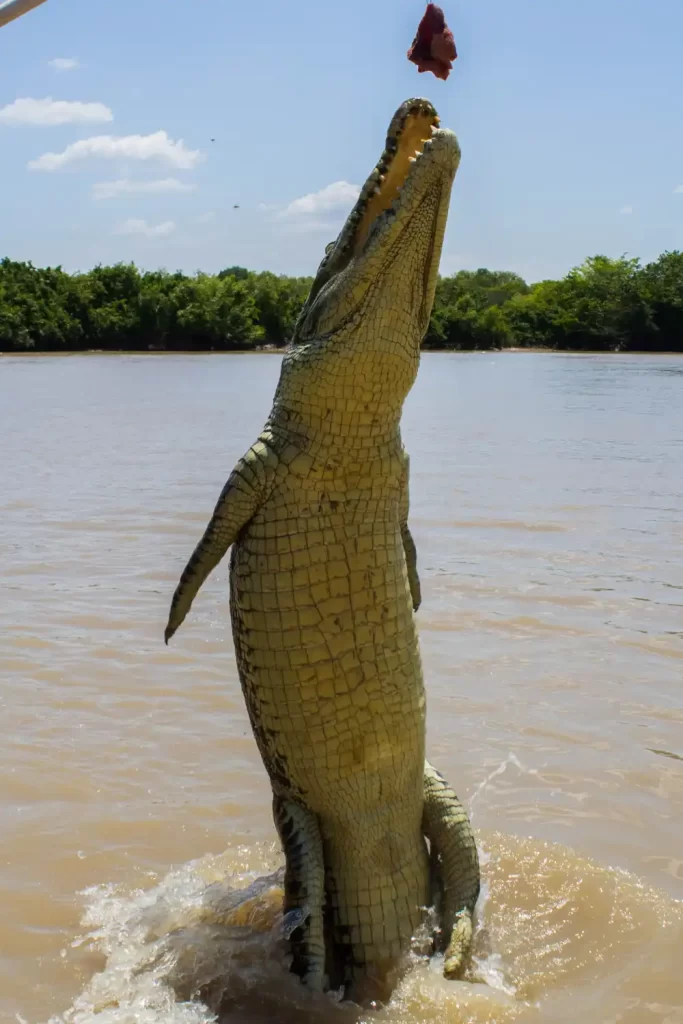
Crocodiles are among the largest and most fearsome predators on the planet. Their size and strength are legendary, but have you ever wondered how their size relates to their weight? It turns out that the weight of a crocodile increases approximately cubically as length increases, which is known as the square-cube law.
Size and Weight
Male saltwater crocodiles are the largest riparian predators in the world, measuring up to 23 feet (7 m) in length and weighing over 2,200 pounds (1,000 kg). In contrast, females are much smaller, growing to be about 10 feet (3 m) long and weighing around 330 pounds (150 kg).
Growth
Crocodiles start their lives fairly small, with newly hatched saltwater crocodiles measuring about 11 inches (28 cm) long and weighing an average of 2.5 ounces (71 g). Surprisingly, these sizes and ages are almost identical to those at average sexual maturity in Nile crocodiles, despite the fact that average adult male saltwater crocodiles are considerably larger than average adult male Nile crocodiles.
As they grow, linear growth eventually decreases and they start getting bulkier at a certain point.
Skull Size
The largest skull of a saltwater crocodile that could be scientifically verified was of a specimen collected in Cambodia and housed in the Muséum national d’Histoire naturelle.
Its skull was 30 inches (76 cm) long and 19 inches (48 cm) wide near its base, with 38.7-inch (98.3 cm) long mandibles.
The length of this specimen is not known, but based on skull-to-total-length ratios for very large saltwater crocodiles, its length was presumably somewhere in the 23-foot range.
The head of a very large male crocodile can reportedly weigh over 440 pounds (200 kg) alone, including the large muscles and tendons at the base of the skull that lend the crocodile its massive biting strength. The largest tooth ever measured on a crocodile was 3.5 inches (9 cm) in length.
Comparisons
Other crocodilians have a proportionately longer skull, like the gharial and the false gharial, but both their skulls and their bodies are less massive than in the saltwater crocodile.
Dangerous Nature
Due to their size and predatory nature, Australian saltwater crocodiles are considered one of the most dangerous animals in Australia. They have no natural enemies in their habitats and are apex predators. They can attack humans without warning, making them a significant threat to human life.
Other Behaviours and Adaptations of the Australian Saltwater Crocodile

Sliding – A Unique Adaptation of Australian Saltwater Crocodiles
Apart from their physical characteristics, Australian saltwater crocodiles have unique behaviours and adaptations that make them fascinating creatures.
One such adaptation is called “sliding.” These crocodiles slide down muddy banks into the water to avoid detection. This behaviour helps them to remain undetected by potential prey or predators. It also allows them to move quickly and efficiently in areas where the terrain is difficult.
The Special Gland in Their Tongue
Crocodiles have a remarkable ability to survive in both freshwater and saltwater environments. One of the adaptations that enable them to do so is the presence of a special gland located on the underside of their tongue. This gland plays a crucial role in regulating the amount of salt in their bodies, allowing them to thrive in habitats with varying levels of salinity.
For a long time, the apparent absence of salt glands in marine and estuarine crocodiles has puzzled scientists. However, recent research has revealed the presence of these glands in the tongue of the Australian saltwater crocodile (Crocodylus porosus).
These glands exude a concentrated secretion of sodium chloride, which helps crocodiles to maintain a proper balance of electrolytes in their bodies.
When exposed to high levels of salt, such as when they are swimming in seawater, the gland in the crocodile’s tongue excretes excess salt from their body.
This ensures that their internal environment remains stable, even in the face of changing external conditions. The gland is similar in ultrastructure to other reptilian salt glands and undoubtedly plays a major role in electrolyte regulation.
Tool Use
Australian saltwater crocodiles have also been observed using tools to lure birds closer to them for an easy meal. This behaviour is not commonly seen in reptiles and is a testament to the intelligence of these creatures.
The crocodiles will use sticks or other objects to attract birds that are nesting nearby. They will hold the stick in their mouth and move it around, mimicking the movements of a bird. This behaviour lures the bird closer to the crocodile, making it easier for them to catch their prey.
Attacks on Humans: Surviving a Crocodile Encounter

Problem crocodiles are often responsible for attacks on humans, as they have become accustomed to associating humans with food.
This is especially true in areas where people fish or hunt near the water’s edge, as the crocs learn to associate the sound of boats or gunshots with an easy meal. In addition, young crocodiles are also known to be more aggressive towards humans, as they are still learning how to hunt and defend themselves.
Crocodile farms play a role in reducing the number of problem crocs in the wild by providing a source of income for local communities and reducing the demand for wild-caught crocs.
These farms raise crocodiles for their meat and skin, which can be sold locally or exported around the world. By providing an alternative source of income, these farms help reduce poaching and illegal hunting of wild crocodiles.
Surviving a crocodile encounter involves staying calm and avoiding sudden movements, as crocs are more likely to attack if they feel threatened or provoked. If you find yourself face-to-face with a crocodile, it is important not to panic. Slowly back away from the animal while keeping your eyes on it at all times.
Studies have shown that crocs primarily prey on small prey such as fish, but will also attack larger animals if the opportunity arises.
This means that even if you are not their preferred prey, you could still be at risk if you get too close to them. It is important to always keep a safe distance from any saltwater crocodiles you encounter in the wild.
Conservation efforts have helped increase the population of saltwater crocs in Australia, but it is important to remember that these animals are still dangerous predators and should be treated with caution and respect.
While some may view them as a threat or nuisance due to their attacks on humans or livestock, it is important to recognize their importance in maintaining healthy ecosystems.
The Death Roll: A Famous Move of the Saltwater Crocodile
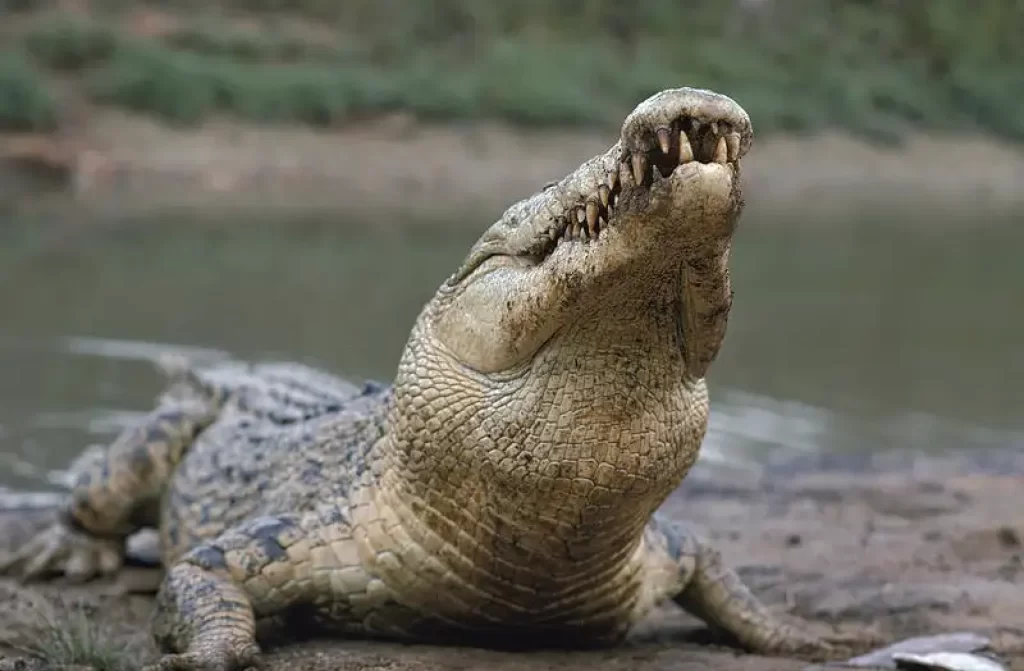
The saltwater crocodile is known for its powerful jaws and incredible strength, but perhaps its most famous move is the death roll.
This signature move is used by the crocodile to subdue and drown its prey, making it easier to hold onto and ultimately kill.
During the death roll, the crocodile will grab onto its prey with its powerful jaws and then rapidly spin its body, twisting the prey underwater.
This spinning motion can disorient and incapacitate the prey, making it easier for the crocodile to hold onto and ultimately kill.
The force of this movement is incredibly strong, with some estimates suggesting that a large saltwater crocodile can generate up to 3,000 pounds of force during the spin.
The death roll is not just used for hunting, but also as a defense mechanism. If a predator or human threatens a crocodile, it may use the death roll to escape or fight back.
This move allows them to quickly turn around in water while maintaining their grip on their prey or attacker.
Despite its name, the death roll does not always result in death for the prey. Some animals are able to escape or survive the attack, although they may be injured or traumatized.
The death roll is not just limited to saltwater crocodiles, as other species of crocodiles also use this move. For example, Alligators and Nile crocodile are known for using a similar technique during hunting and defense.
The Relationship between Australian Saltwater Crocodiles and Humans
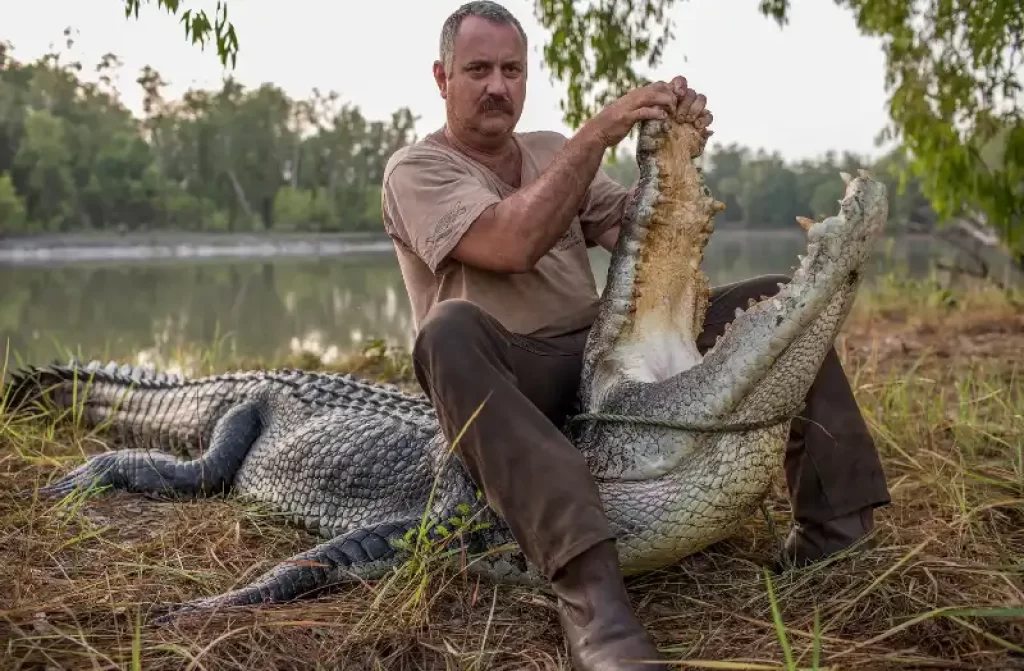
Saltwater crocodiles in Australia are notorious for being one of the most dangerous predators in their habitat, with fatal consequences for those who venture into their territory.
In recent years, an increase in crocodile attacks has been linked to habitat loss due to human activities.
This has forced crocodiles to seek out new areas for breeding and hunting, resulting in more frequent contact with humans.
While warning signs are posted in areas where saltwater crocodiles are known to inhabit, it is important for humans to exercise caution and avoid these areas altogether.
Saltwater crocodiles have incredibly powerful jaws capable of exerting a force of over 3,000 pounds per square inch, making them one of the deadliest predators in nature.
Even if warning signs are not present, it is essential for individuals to remain vigilant when near water sources that may contain these dangerous animals.
The population of saltwater crocodiles in Australia has rebounded since hunting was banned in the 1970s, resulting in more encounters between humans and these dangerous animals.
However, recent media articles suggest a hypothesis that saltwater crocodiles from the Northern Territory of Australia may be responsible for an increase in crocodile attacks on humans in Timor-Leste and nearby locations.
While we know that crocodiles from recovering populations can migrate further afield, even far out to sea, the idea that enough crocodiles are moving to Timor-Leste to have a significant impact on the number of people being attacked is a bold statement that needs solid evidence to back it up.
The proponents of this hypothesis have admitted that there is no clear evidence for any significant movement of crocodiles between Australia and Timor.
Furthermore, attacks on humans have increased throughout the range of the species, and conflict ‘hotspots’ vary with frequently changing trends.
This hypothesis fails to consider range-wide conflict trends and ignores landlocked saltwater crocodile populations, such as the largest single population in Timor-Leste located in a freshwater lake on the Fuiloro plateau, where attacks on humans are known to occur.
It is important to note that the available data suggests that attacks on humans have increased, but accurate estimates are difficult due to a paucity of data from New Guinea, an area known to have a high level of conflict.
Thanks to the dedicated work of organizations like CrocBITE and the collaboration of local and regional crocodile specialists, we are gaining a deeper understanding of the extent of human-saltwater crocodile conflict. Their efforts have shed light on the complex dynamics and challenges associated with interactions between humans and these formidable reptiles
This understanding highlights the need for continued research to identify all possible reasons for attack trends and inform management strategies.
Quick and Fun Facts about Australian Saltwater Crocodiles
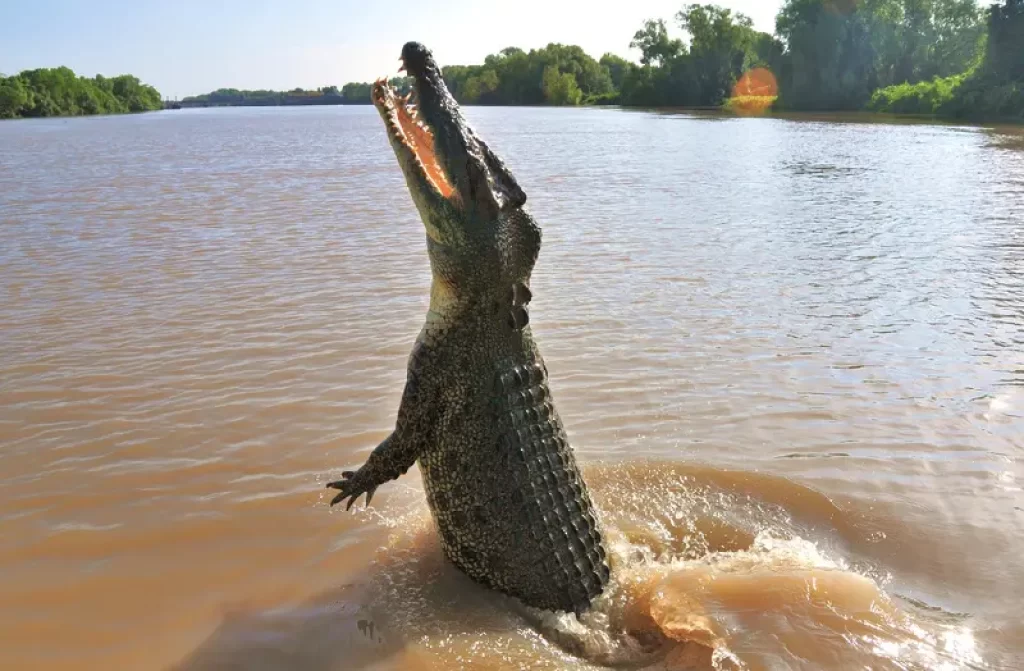
Saltwater Crocodiles are Ancient Creatures
Saltwater Crocodiles are one of the oldest creatures on Earth, dating back over 240 million years to the time of the dinosaurs. While other species have evolved over time, crocs have remained relatively unchanged for the past 200 million years.
Survivors
One theory for the crocodile’s survival is their cold-blooded nature. Unlike most dinosaurs, crocs could withstand colder temperatures and dark conditions following the Yucatan meteor. Another theory suggests their freshwater habitats were less impacted by the meteor.
Saltwater Crocodiles are the Largest Reptiles on earth
Saltwater crocs are the largest reptiles in the world. They can live up to 70 years and grow up to 5 meters long, with some reaching an impressive 20 feet. Adult males can weigh close to 1,000 kg, while baby crocs can weigh as little as 60 g.
Egg Layers
Females lay up to 50 eggs during the wet season, which incubate for about 3 months. The temperature of the nest determines the sex of the saltwater crocodile offspring. Only 1% of hatchlings survive to adulthood.
They have a Powerful Bite
With 68 sharp teeth, saltwater crocs can exert two tonnes of pressure with a single bite. If their teeth break off, new ones grow in their place.
No Sweat
Crocs cannot produce their own heat, which makes Australia’s tropical climate perfect for them. However, they cannot generate body sweat, so they cool off by sitting with their mouths open.
Saltwater Crocodiles are Top Predators
Saltwater crocs are apex predators and will eat almost anything, including smaller reptiles, fish, turtles, and birds. They are known to capture larger prey, such as livestock, buffaloes, and adult humans.
Saltwater Crocodiles’s FAQ
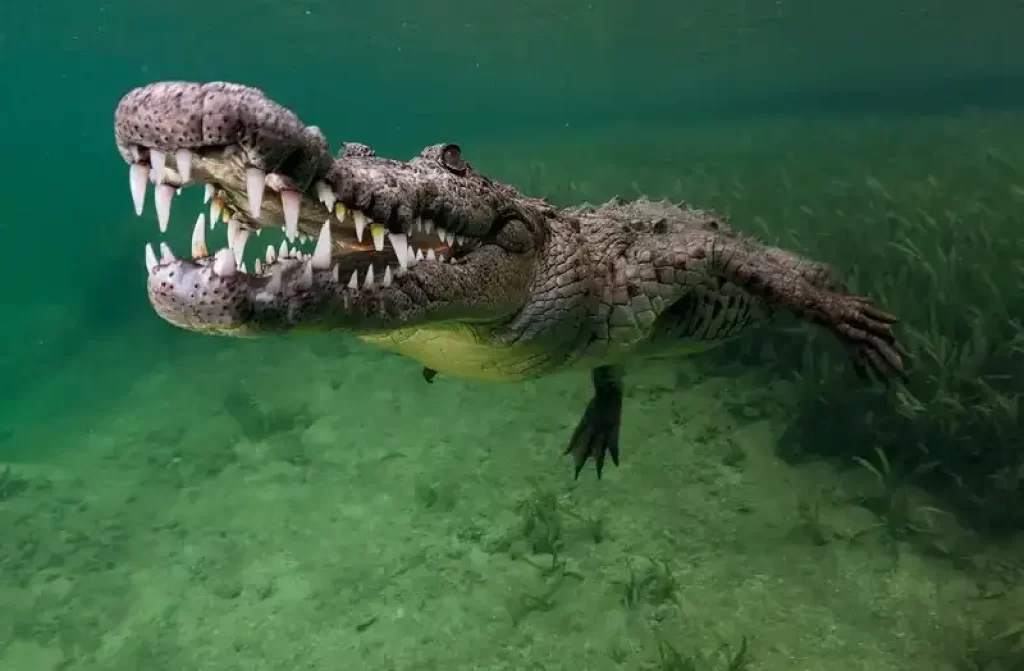
Can Saltwater Crocodiles keep their jaw open underwater?
No, saltwater crocodiles cannot keep their jaw open underwater. Although they are adapted to living in water and can hold their breath for long periods of time, they still need to close their jaws to prevent water from entering their lungs.
When they hunt underwater, they typically ambush their prey from the surface and then drag it to the bottom to consume it.
Can a saltwater crocodile kill a great white shark?
Contrary to popular belief, a saltwater crocodile can potentially kill a great white shark in a fight. While great white sharks are known for their speed and power in the water, saltwater crocodiles are apex predators and have an incredibly strong bite force.
However, such a confrontation between these two formidable predators is unlikely to occur in the wild as they inhabit different environments.
Can a saltwater crocodile live in freshwater?
Yes, saltwater crocodiles can live in freshwater. In fact, these crocodiles are known to inhabit both saltwater and freshwater environments, hence their name.
While they are commonly found in coastal areas such as estuaries, mangrove swamps, and saltwater marshes, they can also be found in rivers, billabongs, and freshwater wetlands.
They are known to travel great distances to find suitable habitats, and their ability to adapt to different environments is one reason for their success as a species.
What are saltwater crocodiles predators?
As apex predators, saltwater crocodiles do not have any natural predators in their habitats. However, their eggs and young may fall prey to a variety of predators, such as monitor lizards, birds, snakes, and smaller crocodiles.
Adult crocodiles can also fall prey to other predators, such as tigers and humans, especially during conflicts over territory or when they become vulnerable due to injury or illness.
However, these cases are relatively rare, as saltwater crocodiles are top predators in their ecosystem and are known for their aggressive and territorial behavior.
What are saltwater crocodiles immune to?
Saltwater Crocodiles have developed an unusual immunity to the toxins found in Cane Toads, a highly invasive species in Australia that is toxic to many predators.
This means that the crocodiles can feed on Cane Toads without experiencing any adverse effects from their toxins.
In fact, research has shown that Saltwater Crocodiles are one of the only predators that can safely consume Cane Toads.
This unique adaptation gives them an advantage over other predators in areas where Cane Toads are prevalent, allowing them to sustain themselves even when other food sources are scarce.
What do saltwater crocodiles eat?
Saltwater crocodiles are apex predators and are known to be opportunistic feeders, which means they will eat almost anything they can catch.
Their diet varies depending on their size and location, but their prey typically includes fish, crustaceans, birds, mammals, and reptiles.
They are known to be able to take down large prey such as water buffalo, wild boar, and even adult human beings.
In addition to their formidable hunting skills, saltwater crocodiles also use vocalizations to communicate with one another. They produce a range of sounds, including barks, hisses, growls, and chirps, which can convey different messages such as aggression, warning, or courtship.
Other species of crocodiles
- Morelet’s Crocodile (Crocodylus moreletii)
- Nile Crocodile (Crocodylus niloticus)
- Mugger Crocodile (Gavialis gangeticus)
- Orinoco Crocodile (Crocodylus intermedius)
- Cuban Crocodile (Crocodylus rhombifer)
- African Dwarf Crocodile (Osteolaemus tetraspis)
References
- Platt, S.G., Elsey, R.M. and Liu, H., 2008. Functional and morphological plasticity of crocodile lungs in response to diving. Journal of Experimental Biology, 211(9), pp.1482-1489.
- MarineBio Conservation Society. Saltwater Crocodiles (Crocodylus porosus). Available at: https://www.marinebio.org/species/saltwater-crocodiles/crocodylus-porosus
- Wikipedia. Saltwater crocodile. Available at: https://en.wikipedia.org/wiki/Saltwater_crocodile
- Northern Territory Government. Crocodile safety. Available at: https://nt.gov.au/__data/assets/pdf_file/0017/202580/crocodile-safety.pdf
- Down To Earth. How Australia’s saltwater crocodiles are being made scapegoats amid increasing conflicts with humans. Available at: https://www.downtoearth.org.in/blog/wildlife-biodiversity/how-australia-s-saltwater-crocodiles-are-being-made-scapegoats-amid-increasing-conflicts-with-humans-79526






